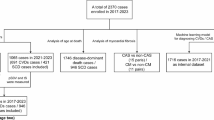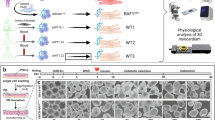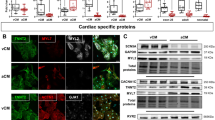Abstract
Congenital heart defects affect 60-85% of patients with RASopathies. We analysed the clinical and molecular characteristics of atrioventricular canal defect in patients with mutations affecting genes coding for proteins with role in the RAS/MAPK pathway. Between 2002 and 2011, 101 patients with cardiac defect and a molecularly confirmed RASopathy were collected. Congenital heart defects within the spectrum of complete or partial (including cleft mitral valve) atrioventricular canal defect were diagnosed in 8/101 (8%) patients, including seven with a PTPN11 gene mutation, and one single subject with a RAF1 gene mutation. The only recurrent mutation was the missense PTPN11 c.124 A>G change (T42A) in PTPN11. Partial atrioventricular canal defect was found in six cases, complete in one, cleft mitral valve in one. In four subjects the defect was associated with other cardiac defects, including subvalvular aortic stenosis, mitral valve anomaly, pulmonary valve stenosis and hypertrophic cardiomyopathy. Maternal segregation of PTPN11 and RAF1 gene mutations occurred in two and one patients, respectively. Congenital heart defects in the affected relatives were discordant in the families with PTPN11 mutations, and concordant in that with RAF1 mutation. In conclusion, our data confirm previous reports indicating that atrioventricular canal defect represents a relatively common feature in Noonan syndrome. Among RASopathies, atrioventricular canal defect was observed to occur with higher prevalence among subjects with PTPN11 mutations, even though this association was not significant possibly because of low statistical power. Familial segregation of atrioventricular canal defect should be considered in the genetic counselling of families with RASopathies.
Similar content being viewed by others
Log in or create a free account to read this content
Gain free access to this article, as well as selected content from this journal and more on nature.com
or
References
Schubbert S, Bollag G, Shannon K : Deregulated Ras signalling in developmental disorders: new tricks for an old dog. Curr Opin Genet Dev 2007; 17: 15–22.
Tidyman WE, Rauen KA : The RASopathies: developmental syndromes of Ras/MAPK pathway dysregulation. Curr Opin Genet Dev 2009; 19: 230–236.
Tartaglia M, Zampino G, Gelb BD : Noonan syndrome: Clinical aspects and molecular pathogenesis. Mol Syndromol 2010; 1: 2–26.
van der Hauwaert LG, Fryns JP, Dumoulin M, Logghe N : Cardiovascular malformations in Turner’s and Noonan’s syndrome. Br Heart J 1978; 40: 500–509.
Burch M, Sharland M, Shinebourne E, Smith G, Patton M, McKenna W : Cardiologic abnormalities in Noonan syndrome: phenotypic diagnosis and echocardiographic assessment in 118 patients. J Am Coll Cardiol 1993; 22: 1189–1192.
Nora JJ, Lortscher RH, Spangler RD : Echocardiographic studies of left ventricular disease in Ullrich-Noonan syndrome. Am J Dis Child 1975; 129: 1417–1420.
Marino B, Digilio MC, Toscano A, Giannotti A, Dallapiccola B : Congenital heart diseases in children with Noonan syndrome: an expanded cardiac spectrum with high prevalence of atrioventricular canal. J Pediatr 1999; 135: 703–706.
Sumner RG, Phillips JH, Jacoby WJ, Tucker DH : Forme fruste of endocardial cushion defect. Am J Med Sci 1967; 254: 266–283.
Nora JJ : Etiologic factors in congenital heart disease. Pediatr Clin North Am 1971; 18: 1059–1074.
DiSegni E, Pierpont MEM, Bass JL, Kaplinsky E : Two dimensional echocardiography in detection of endocardial cushion defect in families. Am J Cardiol 1985; 55: 1649–1652.
Digilio MC, Marino B, Cicini MP, Giannotti A, Formigari R, Dallapiccola B : Risk of congenital heart defects in relatives of patients with atrioventricular canal. Am J Dis Child 1993; 147: 1295–1297.
Digilio MC, Marino B, Giannotti A, Dallapiccola B : Familial atrioventricular septal defect: possibile genetic mechanism. Br Heart J 1994; 72: 301.
Cousineau AJ, Lauer RM, Pierpont ME et al: Linkage analysis of autosomal dominant atrioventricular canal defects: exclusion of chromosome 21. Hum Genet 1994; 93: 103–108.
Clark EB : Mechanisms in the pathogenesis of congenital heart defects; in Pierpont MEM, Moller JH, (eds): Genetics of Cardiovascular Disease. Martinus-Nijoff Publishing: Boston, 1986; pp 3–11.
Clark EB : Pathogenetic mechanism of congenital cardiovascular malformations revisited. Semin Perinatal 1996; 29: 465–472.
Digilio MC, Marino B, Toscano A, Giannotti A, Dallapiccola B : Atrioventricular canal defect without Down sindrome: a heterogeneous malformation. Am J Med Genet 1999; 85: 140–146.
Marino B, Digilio MC : Congenital heart disease and genetic syndromes: specific correlation between cardiac phenotype and genotype. Cardiovasc Pathol 2000; 9: 303–315.
Marino B, Gagliardi MG, Digilio MC et al: Noonan syndrome: structural abnormalities of the mitral valve causing subaortic obstruction. Eur J Pediatr 1995; 154: 949–952.
Digilio MC, Conti E, Sarkozy A et al: Grouping the multiple-lentigines/LEOPARD and Noonan syndromes on the PTPN11 gene. Am J Hum Genet 2002; 71: 389–394.
Digilio MC, Lepri F, Baban A et al: RASopathies: Clinical diagnosis in the first year of life. Mol Syndromol 2010; 1: 282–289.
Sarkozy A, Conti E, Seripa D et al: Correlation between PTPN11 gene mutations and congenital heart defects in Noonan and LEOPARD syndromes. J Med Genet 2003; 40: 704–708.
Sznajer Y, Keren B, Baumann C et al: The spectrum of cardiac anomalies in Noonan syndrome as a result of mutations in the PTPN11 gene. Pediatrics 2007; 119: e1325–e1331.
Tartaglia M, Mehler EL, Goldberg R et al: PTPN11 mutations in Noonan syndrome: Molecular spectrum, genotype-phenotype correlation, and phenotypic heterogeneity. Am J Hum Genet 2002; 70: 1555–1563.
Musante L, Kehl HG, Majewski F et al: Spectrum of mutations in PTPN11 and genotype-phenotype correlation in 96 patients with Noonan syndrome and five patients with cardio-facio-cutaneous syndrome. Eur J Hum Genet 2003; 11: 201–206.
Zenker M, Buheitel G, Rauch R et al: Genotype-phenotype correlations in Noonan syndrome. J Pediatr 2004; 144: 368–374.
Jongmans M, Otten B, Nordam K, van der Burgt I : Genetics and variation in phenotype in Noonan syndrome. Horm Res 2004; 62 (Suppl 3): 56–59.
Bertola DR, Pereira AC, Albano LM, De Oliveira PS, Kim CA, Krieger JE : PTPN11 gene analysis in 74 Brazilian patients with Noonan syndrome or Noonan-like phenotype. Genet Test 2006; 10: 186–191.
Lin AE, Alexander ME, Colan SD et al: Clinical, pathological, and molecular analyses of cardiovascular abnormalities in Costello syndrome: a Ras/MAPK pathway syndrome. Am J Med Genet 2011; 155A: 486–507.
van der Burgt I : Noonan syndrome. Orphanet J Rare Dis 2007; 2: 4.
Voron DA, Hatfield HH, Kalkhoff RK : Multiple lentigines syndrome. Case report and review of the literature. Am J Med 1976; 60: 447–456.
Kavamura NI, Peres CA, Alchhorne MMA, Brunoni D : CFC index for the diagnosis of cardiofaciocutaneous syndrome. Am J Med Genet 2002; 112: 12–16.
Gripp KW, Lin AE, Nicholson L et al: Further delineation of the phenotype resulting from BRAF or MEK1 germline mutations helps differentiate Cardio-facio-cutaneous syndrome from Costello syndrome. Am J Med Genet 2007; 143A: 1472–1480.
Schubbert S, Zenker M, Rowe SL et al: Germline KRAS mutations cause Noonan syndrome. Nat Genet 2006; 38: 331–336.
Neumann TE, Allanson J, Kavamura I et al: Multiple giant cell lesions in patients with Noonan syndrome and cardio-facio-cutaneous syndrome. Eur J Hum Genet 2009; 17: 420–425.
Sarkozy A, Conti E, Digilio MC et al: Clinical and molecular analysis of 30 patients with multiple lentigines LEOPARD sindrome. J Med Genet 2004; 41: e68.
Starr A, Hovaguimian H : Surgical repair of subaortic stenosis in atrioventricular canal defects. J Thorac Cardiovasc Surg 1994; 108: 373–376.
Feit LR, Hansen K, Oyer CE, Werner JC : Unusual combination of congenital heart defects in an infant with Noonan syndrome. Pediatr Cardiol 1995; 16: 95–99.
Marino B, Guccione P, Marcelletti C, Dallapiccola B : Atrioventricular canal without Down syndrome associated with additional cardiac and noncardiac anomalies. Am J Dis Child 1990; 144: 752.
Weismann CG, Hager A, Kaemmerer H et al: PTPN11 mutations play a minor role in isolated congenital heart disease. Am J Med Genet 2005; 136A: 146–151.
Martinelli S, Torreri P, Tinti M et al: Diverse driving forces underlie the invariant occurrence of the T42A, E139D, I282V and T468M SHP2 amino acid substitutions causing Noonan and LEOPARD syndromes. Hum Mol Genet 2008; 17: 2018–2029.
Krenz M, Yutzey KE, Robbins J : Noonan syndrome mutation Q79R in Shp2 increases proliferation of valve primordia mesenchymal cells via extracellular signal-regulated kinase 1/2 signaling. Circ Res 2005; 97: 813–820.
Gow RM, Freedom RM, Williams WG, Trusler GA, Rowe RD : Coarctation of the aorta or subaortic stenosis with atrioventricular septal defect. Am J Cardiol 1984; 53: 1421–1428.
Klues HG, Roberts WC, Maron BJ : Anomalous insertion of papillary muscle directly into anterior mitral leaflet in hypertrophic cardiomyopathy. Significance in producing left ventricular outflow obstruction. Circulation 1991; 84: 1188–1197.
Klues HG, Maron BJ, Dollar AL, Roberts WC : Diversity of structural mitral valve alterations in hypertrophic cardiomyopathy. Circulation 1992; 85: 1651–1660.
Maron MS, Olivotto I, Harrigan C et al: Mitral valve abnormalities identified by cardiovascular magnetic resonance represent a primary phenotypic expression of hypertrophic cardiomyopahy. Circulation 2011; 124: 40–47.
Digilio MC, Marino B, Sarkozy A, Versacci P, Dallapiccola B : The heart in Ras-MAPK pathway disorders; in Zenker M, (ed): Noonan Syndrome and Related Disorders. Monographs on Human Genetics. Karger: Basel, 2009; vol 17: pp 109–118.
Pandit B, Sarkozy A, Pennacchio LA et al: Gain-of-function RAF1 mutations cause Noonan syndrome and LEOPARD syndromes with hypertrophic cardiomyopathy. Nat Genet 2007; 8: 1007–1012.
Lee ST, Ki CS, Lee HJ : Mutation analysis of the genes involved in the Ras-mitogen-activated protein kinase (MAPK) pathway in Korean patients with Noonan syndrome. Clin Genet 2007; 72: 150–155.
Shaw AC, Kalidas K, Crosby AH, Jeffery S, Patton MA : The natural history of Noonan syndrome: a long-term follow-up study. Arch Dis Child 2007; 92: 128–132.
Kosaki K, Suzuki T, Muroya K et al: PTPN11 (protein-tyrosine phosphatase, nonreceptor-type 11) mutations in seven Japanese patients with Noonan syndrome. J Clin Endocrinol Metab 2002; 87: 3529–3533.
Maheshwari M, Belmont J, Fernbach S et al: PTPN11 mutations in Noonan syndrome type I: detection of recurrent mutations in exons 3 and 13. Hum Mut 2002; 20: 298–304.
Becker K, Hughes H, Howard K et al: Early fetal death associated with compound heterozygosity for Noonan syndrome-causative PTPN11 mutations. Am J Med Genet 2007; 143A: 1249–1252.
Brasil AS, Malaquias AC, Wanderley LT et al: Co-occurring PTPN11 and SOS1 gene mutations in Noonan syndrome: does this predict a more severe phenotype? Arq Bras Endocrinol Metabol 2010; 54: 717–722.
Digilio MC, Capolino R, Marino B, Sarkozy A, Dallapiccola B. : Congenital intrahepatic portosystemic venous shunt: An unusual feature in LEOPARD syndrome and in Neurofibromatosis type 1. Am J Med Genet 2005; 134A: 457–458.
Limongelli G, Pacileo G, Marino B et al: Prevalence and clinical significance of cardiovascular abnormalities in patients with the LEOPARD syndrome. Am J Cardiol 2007; 100: 736–741.
Limongelli G, Sarkozy A, Pacileo G et al: Genotype–phenotype analysis and natural history of left ventricular hypertrophy in LEOPARD syndrome. Am J Med Genet 2008; 146A: 620–628.
Razzaque MA, Nishizawa T, Komoike Y et al: Germline gain-of-function mutations in RAF1 cause Noonan syndrome. Nat Genet 2007; 39: 1013–1017.
Sarkozy A, Carta C, Moretti S et al: Germline BRAF mutations in Noonan, LEOPARD, and cardiofaciocutaneous syndromes: molecular diversity and associated phenotypic spectrum. Hum Mutat 2009; 30: 695–702.
Acknowledgements
This work was funded in part by grants from Telethon-Italy (GGP10020), ERA-Net for research programs on rare diseases 2009 (NSEuroNet) and Programma di collaborazione Italia-USA 2010 (11US/10) to MT.
Author information
Authors and Affiliations
Corresponding author
Ethics declarations
Competing interests
The authors declare no conflict of interest.
Additional information
Supplementary Information accompanies the paper on European Journal of Human Genetics website
Supplementary information
Rights and permissions
About this article
Cite this article
Digilio, M., Romana Lepri, F., Lisa Dentici, M. et al. Atrioventricular canal defect in patients with RASopathies. Eur J Hum Genet 21, 200–204 (2013). https://doi.org/10.1038/ejhg.2012.145
Received:
Revised:
Accepted:
Published:
Issue date:
DOI: https://doi.org/10.1038/ejhg.2012.145
Keywords
This article is cited by
-
Genetics of atrioventricular canal defects
Italian Journal of Pediatrics (2020)



